When it comes to keeping your motorcycle in peak condition, knowing how to tackle issues before they escalate is essential. You might be surprised at how simple maintenance tasks can save you from costly repairs down the line. From understanding common problems specific to your model to inspecting vital systems like the battery and tires, there's a lot to take into account. By following a few key strategies, you can guarantee a smoother ride and greater safety. So, are you ready to discover the top tips that can transform your motorcycle maintenance routine?
Key Takeaways
- Regularly inspect and maintain the electrical system to prevent starting issues and ensure reliable performance.
- Keep the fuel system clean and use high-quality fuel to avoid performance degradation and engine damage.
- Monitor tire pressure and tread depth weekly to ensure safety and optimal handling while riding.
- Conduct routine brake checks to ensure pads are thick enough and fluid levels are adequate for effective stopping power.
Understand Common Ducati Problems
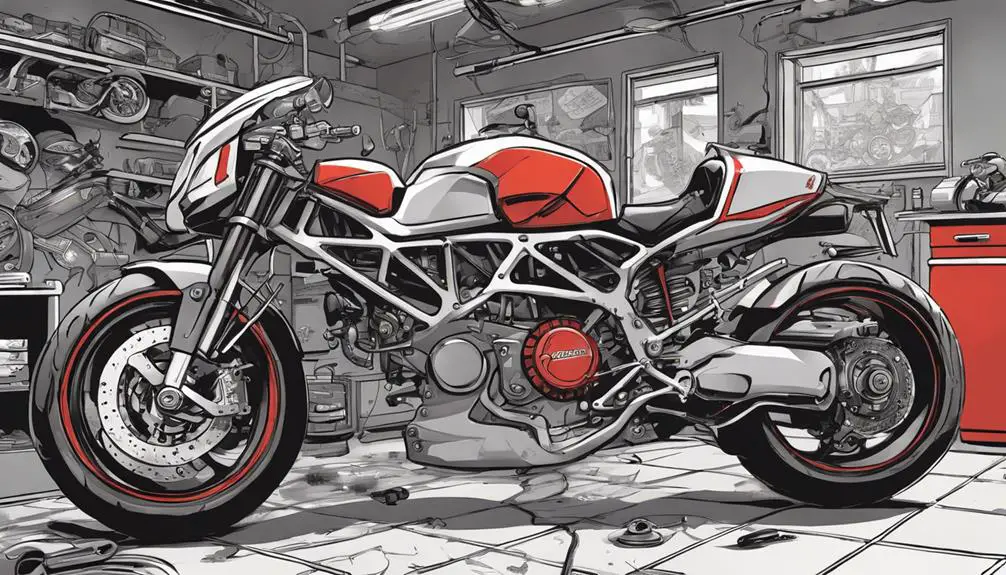
When it comes to Ducati motorcycles, knowing the common issues they face can help you tackle problems before they escalate. Ducati bikes are renowned for their performance, but they can have a few quirks.
One common issue is the electrical system, particularly with wiring and connectors. It's vital to keep an eye on these components, as corrosion can lead to unreliable starts or even shutdowns during rides.
Another area to watch is the fuel system. Clogging in the fuel injectors can affect performance, so regular maintenance is key. You'll want to check your fuel filters and clean the injectors periodically.
Chain maintenance is also essential; a poorly maintained chain can lead to premature wear on your sprockets, impacting your ride quality.
Don't forget about the cooling system, either. Overheating can be a problem, especially in stop-and-go traffic. Keep an eye on coolant levels and look for leaks.
Finally, pay attention to the brakes. If you notice any unusual noises or a spongy feel, it's time to inspect your brake pads and fluid.
Check the Battery Health
Checking your motorcycle's battery health is essential for guaranteeing reliable performance and preventing unexpected breakdowns. A well-maintained battery powers your ride, allowing you to hit the open road without worry.
Start by inspecting the battery terminals for corrosion or dirt. Clean them thoroughly with a wire brush and a solution of baking soda and water. This simple step can greatly enhance your battery's efficiency.
Next, check the charge level. If you have a multimeter, measure the voltage. A healthy battery should read around 12.6 volts or higher when fully charged. If it's lower, you might need to recharge it or consider a replacement.
Don't forget to inspect the battery's age. Most motorcycle batteries last about three to five years. If yours is older, it may be time to invest in a new one.
Regularly checking your battery health not only saves you from being stranded but also allows you to enjoy the freedom of riding without unexpected interruptions. Embrace the open road, and guarantee your battery is in top shape for all your adventures ahead!
Inspect the Electrical System
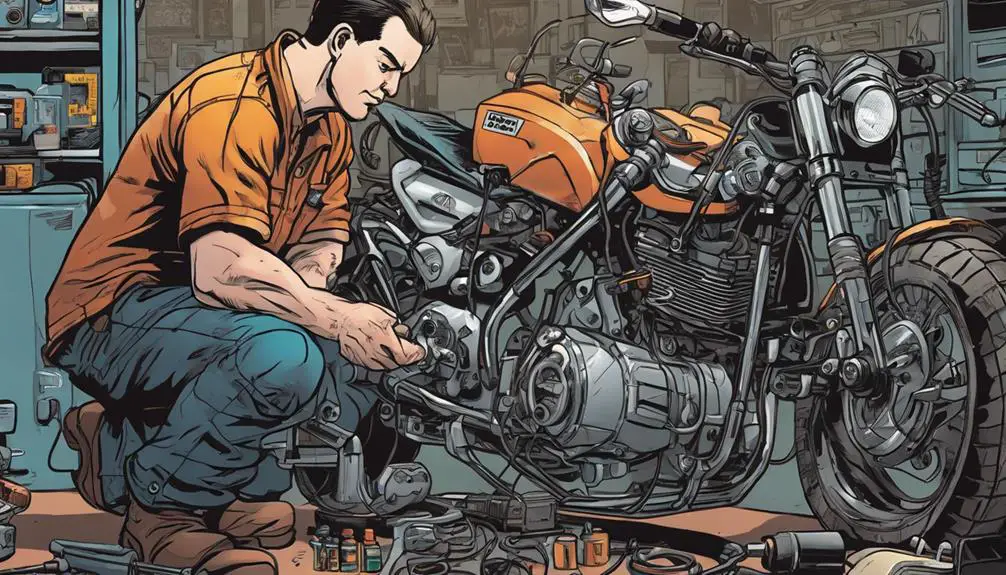
Inspecting the electrical system is essential for guaranteeing your motorcycle runs smoothly and reliably. Start by checking the wiring for any signs of wear or damage. Loose connections can lead to frustrating power losses, so make certain everything's snug.
Next, examine your fuses; a blown fuse could be the reason your lights or signals aren't working.
Don't forget to inspect the ignition system. The spark plugs should be clean and free of deposits; otherwise, they mightn't ignite the fuel properly, leaving you stranded. If you're feeling adventurous, consider testing the coils and other ignition components to verify they're firing correctly.
Also, pay attention to your charging system. A weak or failing regulator can drain your battery faster than you think. Use a multimeter to check the voltage while the engine's running—this'll help you confirm everything's functioning as it should.
Evaluate Fuel Quality
When troubleshooting motorcycle issues, evaluating fuel quality is essential.
You should check the fuel type, inspect its smell, and assess how long it's been sitting.
Poor fuel can lead to performance problems, so let's get to the bottom of it.
Check Fuel Type
You should often guarantee that the fuel you use is of high quality, as poor fuel can lead to performance issues in your motorcycle. To achieve the freedom you crave on the open road, you've got to make sure your bike runs smoothly. Start by checking the octane rating recommended by your manufacturer.
Using fuel with a lower octane can cause knocking, which mightn't only rob you of power but can also damage your engine over time.
Next, consider the source of your fuel. Fill up at reputable stations known for their clean tanks and high turnover rates. If you've been using the same gas station for a while, pay attention to any changes in your motorcycle's performance.
Sometimes, a bad batch can sneak in, and you don't want to be caught off guard.
Lastly, avoid fuel that's been sitting in the tank for too long, as it can degrade and lead to issues like clogging injectors.
Inspect Fuel Smell
A strong, unusual smell of fuel can signal potential quality issues that may affect your motorcycle's performance. When you catch a whiff of something off, it's time to take action. Evaluating fuel quality is essential for ensuring your ride stays smooth and reliable.
Here's what you should do:
- Sniff it Out: Trust your instincts. If the fuel smells sour or overly pungent, it might be contaminated.
- Visual Inspection: Look for unusual colors or sediments in the fuel. Clear, bright gasoline is ideal; anything else could be a problem.
- Check for Water: Water contamination can happen. If you see bubbles or a cloudy appearance, it's time to drain that tank.
- Fuel Source Review: Reflect on where you bought your fuel. If it's from a sketchy station, consider changing your supply for better quality options.
Assess Fuel Age
Evaluating the age of your fuel is essential, as gasoline can degrade over time and lose its effectiveness. If you're looking to ride free and feel that wind in your hair, you need your bike to perform at its best. Fresh fuel keeps your engine running smoothly, while old gasoline can cause starting issues and poor performance.
Check the date you filled up your tank. If it's been sitting for more than a month or two, it's time to take action. Water and contaminants can creep in, especially if the tank's exposed to temperature fluctuations. If you suspect your fuel's too old, consider draining it and replacing it with fresh gasoline.
When you fill up, opt for reputable stations that offer high-quality fuel. Look for options with fuel stabilizers if you plan to store your bike for a while. These additives can help prolong your fuel's life and keep your engine running strong.
Monitor Tire Condition
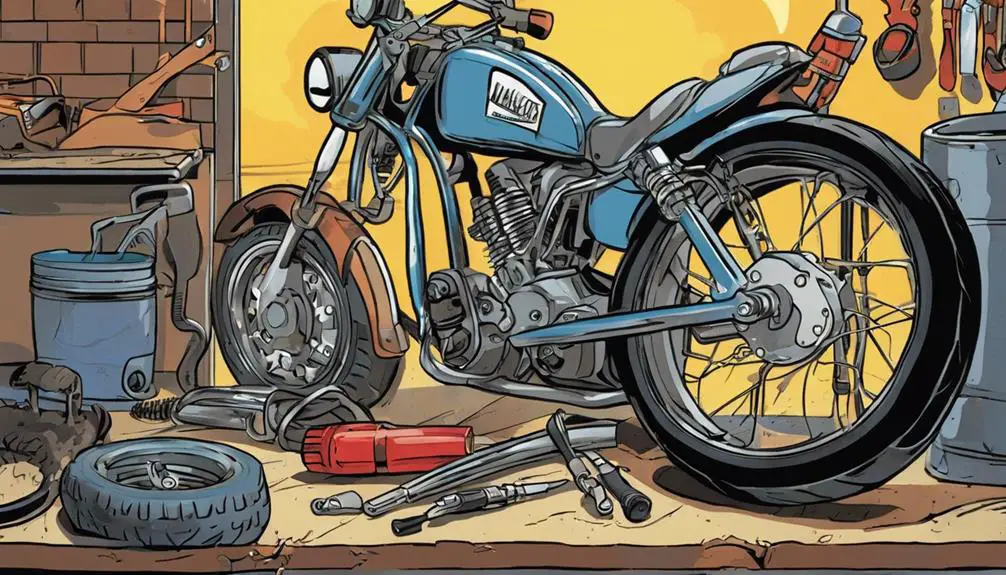
Regularly checking your motorcycle's tire condition can prevent potential accidents and enhance overall performance. Tires are your only contact with the road, so keeping them in top shape is vital for a smooth ride.
Here are four essential checks to guarantee your tires are ready for the journey ahead:
- Tread Depth: Use a tread depth gauge or the penny test. Confirm your tires have sufficient tread to grip the road effectively.
- Air Pressure: Check tire pressure weekly. Under-inflated tires can lead to blowouts and decreased fuel efficiency, while over-inflated ones can reduce traction.
- Visual Inspection: Look for cracks, bulges, or foreign objects embedded in the tire. Any sign of wear or damage could compromise your safety.
- Alignment and Balance: Confirm your tires are properly aligned and balanced. Misalignment can lead to uneven wear and affect handling.
Review Brake Performance
When it comes to your motorcycle's safety, reviewing brake performance is essential.
You should inspect the brake pads regularly, check fluid levels, and test the response time to guarantee everything's functioning properly.
Keeping up with these checks can prevent potential issues and keep your rides smooth.
Inspect Brake Pads Condition
To guarantee your motorcycle stops effectively, check the condition of your brake pads regularly.
Worn-out brake pads can lead to decreased performance, putting your safety at risk. Embrace the freedom of the open road by ensuring your bike is in top shape.
Here's how to inspect your brake pads:
- Visual Inspection: Look for any signs of wear, such as grooves or uneven surfaces. If they're less than 1/8 inch thick, it's time to replace them.
- Listen for Sounds: Pay attention while riding. Squeaking or grinding noises usually indicate that your pads are worn and need replacement.
- Check for Vibration: If you feel a pulse or vibration when you brake, your brake pads may be uneven. This could affect your braking power and control.
- Evaluate Brake Fluid: While we're not diving into fluid levels just yet, be aware that low brake fluid can also affect brake performance.
Check Fluid Levels Regularly
Checking your brake fluid levels often guarantees your motorcycle's braking system performs at its best. When you hit the open road, you want to feel confident in every twist and turn. Regularly checking your brake fluid isn't just a routine task; it's vital for your freedom. Low brake fluid can lead to a spongy feel or, worse, total brake failure.
To check your fluid levels, locate the master cylinder, typically near the handlebars. Look for the fill line—if the fluid's below that mark, it's time to top it off. Make sure you use the correct type of brake fluid specified in your owner's manual. Mixing different types can compromise your braking system and put your safety at risk.
While you're at it, inspect the fluid's color. Clear or light amber is ideal. If it appears dark or contaminated, consider a full brake fluid flush. This simple act not only guarantees your brakes respond swiftly but also enhances your motorcycle's overall performance.
When you're in tune with your bike, you'll experience the liberation of riding without fear. So, check those fluid levels and maintain the thrill of the ride!
Test Brake Response Time
A quick test of your brake response time guarantees your motorcycle stops efficiently and safely when you need it most. To verify your brakes are up to par, follow these simple steps:
- Find a Safe Space: Look for a flat, open area free of obstacles where you can test your brakes without distractions.
- Accelerate Smoothly: Ride at a moderate speed, around 20-30 mph, to gauge how your brakes respond under normal conditions.
- Apply the Brakes: Firmly squeeze the brake lever and pedal simultaneously. Pay attention to how quickly your motorcycle slows down and stops.
- Evaluate Feel and Sound: Listen for any unusual noises and feel for vibrations. If something feels off, it's time to investigate further.
Testing your brake response time isn't just about safety; it's about embracing the freedom of the ride.
When you know your brakes are reliable, you can focus on the thrill of the journey instead of worrying about potential issues.
Regularly checking your brake performance keeps your ride liberating and exhilarating, paving the way for countless adventures ahead.
Examine Cooling System
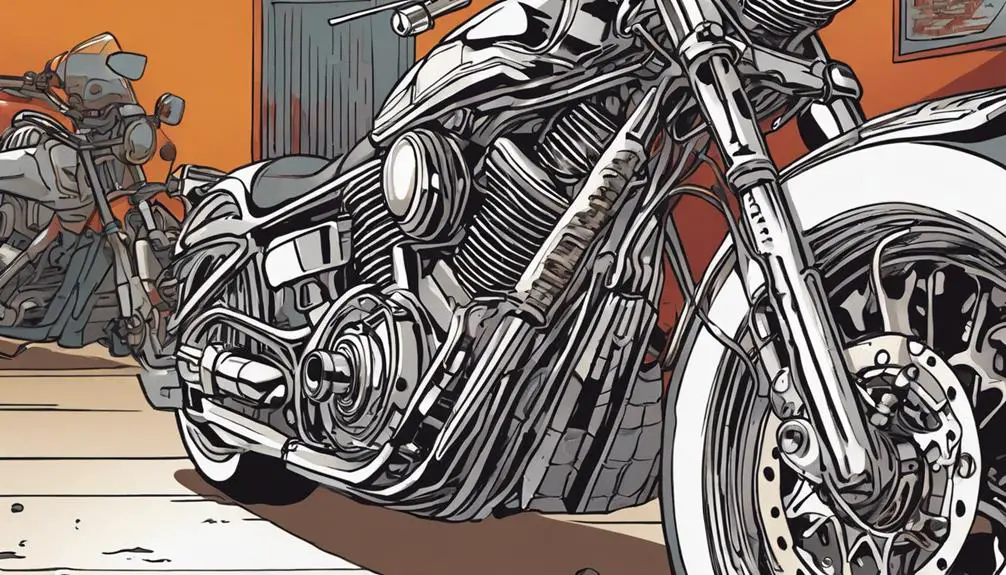
Inspect the cooling system regularly, as it plays an essential role in preventing your motorcycle from overheating. A well-functioning cooling system guarantees your bike runs smoothly and keeps your adventures alive.
Start with the coolant level; make certain it's where it should be. Too little coolant can lead to engine trouble, so top it off if necessary.
Next, check hoses and connections for any signs of wear or leaks. A small leak can quickly escalate into a major issue when you're out on the open road. If you spot anything unusual, consider replacing those parts to maintain reliability.
Pay attention to the radiator, too. Make sure it's free from debris and dirt that could block airflow. Cleaning it regularly will help your bike breathe easier and run cooler.
Maintain Chain and Sprockets
Keeping your chain and sprockets in top shape is essential for a smooth ride.
You should establish a regular cleaning schedule and understand the best lubrication techniques to extend their lifespan.
Plus, knowing the wear and tear indicators can help you catch issues before they become major problems.
Regular Cleaning Schedule
Establishing a regular cleaning schedule helps guarantee your motorcycle's chain and sprockets stay in peak condition. A well-maintained chain and sprocket system not only enhances your bike's performance but also extends its lifespan. Here's how to keep them clean and ready for adventure:
- Frequency: Clean your chain and sprockets every 500-600 miles, or after riding in wet or muddy conditions.
- Inspection: Check for dirt, grime, and wear during each cleaning session. This proactive step can prevent major issues down the road.
- Tools: Gather essential cleaning supplies like a soft brush, chain cleaner, and a microfiber cloth. Keep these handy for quick access.
- Technique: Use a gentle scrubbing motion to remove debris, ensuring you don't damage the components. Focus on hard-to-reach areas where dirt tends to accumulate.
Lubrication Techniques Explained
Proper lubrication is essential for maintaining your motorcycle's chain and sprockets, ensuring smooth operation and prolonging their lifespan.
Start by choosing a high-quality chain lube that suits your riding conditions—wet, dry, or a versatile option.
Clean the chain before applying lubricant; dirt buildup can hinder performance. Use a dedicated chain cleaner or degreaser, and scrub gently with a brush to remove grime.
Once your chain is clean and dry, it's time to apply the lube. Position your motorcycle on a stand, allowing the rear wheel to spin freely. This makes it easier to cover the entire chain evenly.
Spray the lubricant on the inside of the chain while rotating the wheel slowly. Aim for a light, even coating; over-lubricating can attract more dirt and debris.
After applying, let it sit for a few minutes to penetrate. Wipe off any excess with a cloth to prevent fling-off during your ride.
Make this a regular part of your maintenance routine, ideally after every few rides or according to your riding style.
Wear and Tear Indicators
How can you tell when your motorcycle's chain and sprockets are wearing out?
Keeping a close eye on these components is essential for a smooth ride and your safety. Here are some signs that indicate it's time for maintenance:
- Excessive Slack: If your chain has more slack than usual, it could be a sign of wear. A properly adjusted chain should have minimal play.
- Visible Damage: Look for kinks, rust, or broken links in the chain. Any visible damage is an indicator that it needs replacement.
- Sprocket Wear: Inspect the teeth of the sprockets. If they're pointed, hooked, or worn down, they need to be replaced to avoid further damage.
- Unusual Noises: If you hear grinding or rattling noises while riding, it may mean your chain and sprockets are reaching the end of their lifespan.
Staying proactive about these wear indicators not only enhances your motorcycle's performance but liberates you from potential breakdowns.
After all, the open road awaits, and you want to ride without worry!
Analyze Engine Performance
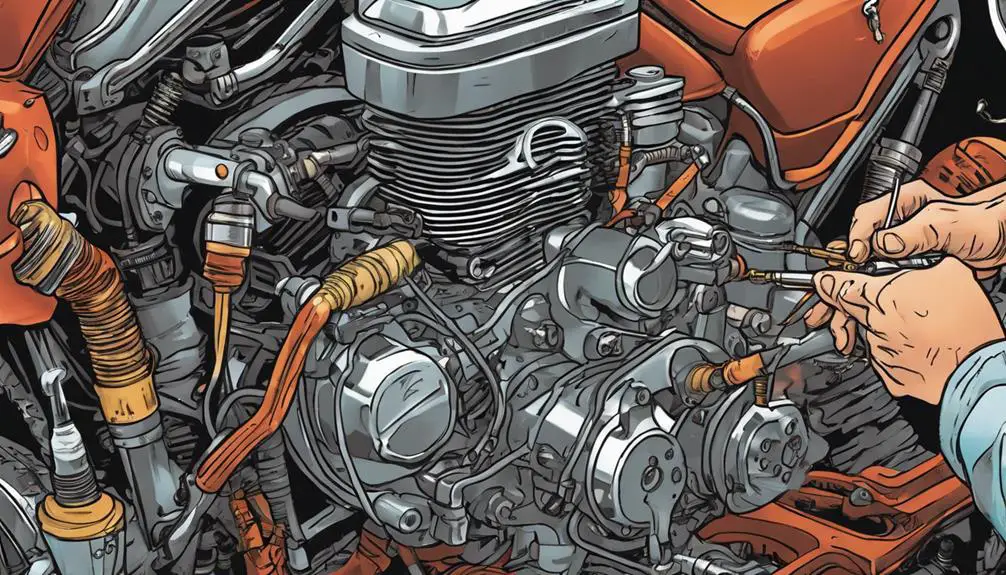
Analyzing your motorcycle's engine performance involves closely monitoring various indicators like throttle response, fuel efficiency, and unusual noises.
Start by paying attention to how your bike accelerates. If it hesitates or feels sluggish, it might be time to dig deeper. Fuel efficiency is another vital factor; if you're filling up more often than usual, something's off.
Next, listen for any strange sounds. Rattles, knocking, or grinding can signal underlying issues that need addressing. Don't ignore these signs; they're your bike's way of communicating its needs.
Check the engine temperature too. If it's running hotter than normal, you could be facing cooling system problems or a failing thermostat.
Lastly, consider using diagnostic tools. They can give you insights into error codes and performance metrics, helping you make informed decisions.
Schedule Regular Maintenance
Scheduling regular maintenance guarantees your motorcycle runs smoothly and helps prevent costly repairs down the road. By taking the time to care for your ride, you're investing in the freedom of the open road.
Regular check-ups not only extend your bike's lifespan but also enhance your overall riding experience. Here's how you can stay ahead:
- Oil Changes: Change the oil every 3,000 to 5,000 miles to keep the engine running clean and efficient.
- Tire Inspections: Check your tire pressure and tread regularly. Properly inflated tires improve handling and fuel efficiency.
- Brake Checks: Inspect your brakes every few months. This guarantees your safety and provides peace of mind on every ride.
- Chain Maintenance: Keep an eye on your chain's tension and lubrication. A well-maintained chain enhances performance and prolongs the life of your motorcycle.
When you make regular maintenance a priority, you're not just caring for your bike; you're embracing the spirit of liberation that comes with every ride.
Frequently Asked Questions
How Can I Improve My Motorcycle's Fuel Efficiency?
To improve your motorcycle's fuel efficiency, you can start by checking tire pressure regularly; under-inflated tires can waste fuel.
Keep your engine well-maintained with regular oil changes and air filter replacements.
You should also avoid aggressive riding—smooth acceleration and braking help conserve fuel.
Ultimately, consider reducing excess weight on your bike, as every pound counts.
What Are the Signs of a Failing Motorcycle Clutch?
When you're riding, you might notice your motorcycle's clutch slipping or engaging late.
Maybe you hear strange noises or feel a vibration that wasn't there before. These signs can signal a failing clutch, and ignoring them might lead to bigger issues.
If you find it hard to shift gears or notice a burning smell, it's time to take a closer look.
Don't let these signs hold you back from the freedom of the open road!
How Do I Choose the Right Motorcycle Tires?
Choosing the right motorcycle tires means understanding your riding style and the terrain you'll tackle.
Consider factors like tire type, weather conditions, and your bike's specifications.
You'll want tires that offer good grip and stability, especially if you're hitting twisty roads or off-road trails.
Don't forget to check reviews and seek advice from fellow riders to guarantee you're making the best choice for your freedom on two wheels.
What Safety Gear Should I Wear While Riding?
You wouldn't believe how much freedom a good ride can bring, but without the right safety gear, that thrill can quickly turn into a nightmare.
Always wear a DOT-approved helmet to protect your head; it's non-negotiable.
Layer up with a durable jacket, gloves, and riding pants to shield yourself from the elements and potential slides.
Don't forget sturdy boots for ankle support.
Gear up, embrace the ride, and stay safe while you're out there!
How Can I Prevent Rust on My Motorcycle?
To prevent rust on your motorcycle, you've gotta stay proactive.
Regularly wash your bike to remove dirt and moisture, and dry it thoroughly afterward.
Apply a protective wax or sealant to the paint and metal surfaces to create a barrier against moisture.
Keep your bike in a dry, covered area, especially during harsh weather.
Conclusion
By staying proactive with your motorcycle maintenance, you can greatly reduce the likelihood of issues down the road.
Did you know that regular maintenance can extend your bike's lifespan by up to 50%?
Keeping an eye on the battery, electrical system, and fuel quality, along with other critical components, guarantees a smoother ride and greater safety.
So, take these tips to heart, and enjoy the thrill of the open road with confidence!